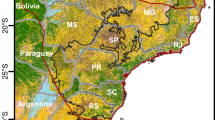Summary
-
1.
Population dynamics of a univoltine butterflyParnassius glacialis (Lepidoptera: Papilionidae) was studied with mark-recapture methods for three successive generations in a hilly region in Kanazawa City, Ishikawa Prefecture, Japan in 1981–1983.
-
2.
Jolly (1965) andSeber's (1973) method was applied to the mark-recapture data to estimate population parameters (daily survival rate, longevity, population size, sex ratio, etc.).
-
3.
Sampling ratios were at least 50% and 30% for males and females, respectively.
-
4.
Mean daily survival rate for males ranged 0.81–0.86 and that for females 0.80–0.84. Mean longevity was about 4–7 days for the males and about 5 days for the females. Spiders killed more males than females. Maximum longevity for an individual recorded during the study was 31 days for males and 18 days for females.
-
5.
Emergence of the butterflies was later and less synchronous in 1981 than in 1982 and 1983. This was thought to be due to later extinction of heavier snow in 1981 than in the other years.
-
6.
The population remained relatively stable for the three successive generations, with estimated total numbers of 914, 1277, and 869.
-
7.
Estimated sex ratio (% females) was 30–40% at emergence
Similar content being viewed by others
References
Brown, I. L. andP. R. Ehrlich (1980) Population biology of the checkerspot butterfly,Euphydryas chalcedona. Structure of the Jasper Ridge colony.Oecologia 47: 239–251.
Cook, L. M., K. Frank andL. P. Brower (1971) Experiments on the demography of tropical butterflies. I. Survival rate and density in two species ofParides.Biotropica 3: 17–20.
Dowdeswell, W. H., R. A. Fisher andE. B. Ford (1940) The quantitative study of populations in the Leipdoptera. I.Polyommatus icarus Rott.Ann. Eugen. 10. Pt.2: 123–136.
Dowdeswell, W. H., R. A. Fisher andE. B. Ford (1949) Ditto. II.Maniola jurtina L.Heredity 3: 67–84.
Ehrlich, P. R. (1965) The population biology of the butterfly,Euphydryas editha. II. The structure of the Jasper Ridge colony.Evolution 19: 327–336.
Ehrlich, P. R., R. R. White, M. C. Singer, S. W. McKechnie andL. E. Gilbert (1975) Checkerspot butterflies: A historical perspective.Science 188: 221–228.
Hirose, Y., Y. Suzuki, M. Takagi, K. Hiehata, M. Yamasaki, H. Kimoto, M. Yamanaka, M. Iga andK. Yamaguchi (1980) Population dynamics of the citrus swallowtail,Papilio xuthus Linne (Lepidoptera: Papilionidae): Mechanisms stabilizing its numbers.Res. Popul. Ecol. 21: 260–285.
Hokyo, N. andE. Kuno (1977) Life table studies on the paddy field population of the green rice leafhopper,Nephotettix cincticeps Uhler (Hemiptera: Cicadellidae), with special reference to the mechanism of population regulation.Res. Popul. Ecol. 19: 107–124.
Itô, Y. andM. Sakiyama andM. Osada (1975) Population dynamics ofPieris rapae crucivora Boisduval (Lepidoptera: Pieridae), an introduced insect pest in Okinawa. II. Features of the population dynamics based on the results of one-year survey.Jap. J. Appl. Ent. Zool. 19: 29–34.
Iwao, S. (1971) Dynamics of numbers of a phytophagous lady-beetle,Epilachna vigintioctomaculata, living in patchily distributed habitats.Proc. Adv. Study Inst. Dynamics Number Popul. (Oosterbeek, 1970): 129–147.
Jolly, G. M. (1965) Explicit estimates from capture-recapture data with both death and immigration-stochastic model.Biometrika 52: 225–247.
Kanazawa Meteorological Observatory (1980–1983) “Kisho-Geppyo”.
Kiritani, K., N. Hokyo, T. Sasaba andF. Nakasuji (1970) Studies on population dynamics of the green rice leafhopper,Neophotettix cincticeps Uhler: Regulatory mechanism of the population density.Res. Popul. Ecol. 12: 137–153.
Matsumoto, K. (1984) Population dynamics ofLuehdorfia jpaonica Leech (Lepidoptera: Papilionidae). I. A preliminary study on the adult population.Res. Popul. Ecol. 26: 1–12.
Nakamura, K. andT. Ohgushi (1979) Studies on the population dynamics of a thistle feeding lady beetle,Henosepilachna pustulosa (Kôno) in a cool temperate climax forest. I. The estimation of adult population parameters by the marking, release and recapture method.Res. Popul. Ecol. 20: 297–314.
Nakamura, K. andT. Ohgushi (1981) Ditto. II. Life tables, key-factor analysis, and detection of regulatory mechanisms.Res. Popul. Ecol. 23: 210–231.
Nakasuji, F. (1982) Population dynamics of a migrant skipper butterflyParnara guttata (Lepidoptera: Hesperiidae) II. Survival rates of immature stages in paddy fields.Res. Popul. Ecol. 24: 157–173.
Scott, J. A. (1973a) Convergence of population biology and behaviour in two sympatric butterflies,Neominois ridingsii (Papilionoidea, Nymphalidae) andAmblyscirtes simius (Hesperioidea, Hesperiidae).J. Anim. Ecol. 42: 663–672.
Scott, J. A. (1973b) Population biology and adult behavior of the circumpolar butterfly,Parnassius phoebus F. (Papilionidae).Ent. Scand. 4: 161–168.
Scott, J. A. (1973c) Adult behavior and population biology of two skippers (Hesperiidae) mating in contrasting topographic sites.J. Res. Lepid. 12: 181–196.
Scott, J. A. (1973d) Lifespan of butterflies.J. Res. Lepid. 12: 225–230.
Scott, J. A. (1974) The interaction of behavior, population biology, and environment inHypaurotis crysalus (Lepidoptera).Amer. Midl. Natur. 91: 383–394.
Seber, G. A. F. (1973)The estimation of animal abundance and related parameters. Griffin, London.
Tabashnik, B. E. (1980) Population structure of pierid butterflies. III. Pest populations ofColias philodice eriphyle.Oecologia 47: 175–183.
Turner, J. R. G. (1963) A quantitative study of a Welsh Colony of the large heath butterfly,Coenonympha tullia Müller (Lepidoptera).Proc. R. Ent. Lond. (A) 38: Pts.7–9: 101–112.
Watanabe, M. (1978) Adult movements and resident ratios of the black-veined whiteAporia crataegi, in a hilly region.Jap. J. Ecol. 28: 101–109.
Watanabe, M. (1981) Population dynamics of the swallowtail butterfly,Papilio xuthus L., in a deforested area.Res. Popul. Ecol. 23: 74–93.
Watt, W. B., F. S. Chew, L. R. G. Snyder, A. G. Watt andD. E. Rothchild (1977) Population structure of pierid butterflies. I. Numbers and movements of some montaneColias species.Oecologia 27: 1–22.
Watt, W. B., D. Han, B. E. Tabashnik (1979) Population structure of pierid butterflies. II. A “native” population ofColias philodice eriphyle in Colorado.Oecologia 44: 44–52.
Author information
Authors and Affiliations
Rights and permissions
About this article
Cite this article
Matsumoto, K. Population dynamics of the japanese clouded apolloParnassius glacialis butler (Lepidoptera: Papilionidae). I. changes in population size and related population parameters for three successive generations. Res Popul Ecol 27, 301–312 (1985). https://doi.org/10.1007/BF02515468
Issue Date:
DOI: https://doi.org/10.1007/BF02515468




